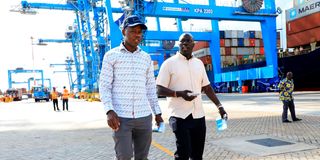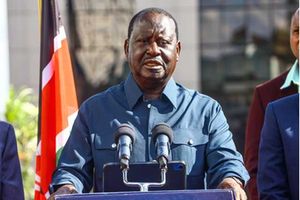Ruto order gives Mombasa port an edge over rival Dar

Kenya Ports Authority MD William Ruto and another official during port stakeholders meeting with President William Ruto at the KPA new container terminal in Mombasa last week.
President William Ruto’s announcement of a raft of measures to improve efficiency will give the Port of Mombasa an edge over its biggest competitor, Dar es Salaam. The measures include 24-hour operations, reducing weighbridges on the Malaba-Mombasa road to two for transit cargo and privatising supply of scanners.
Latest data show Dar winning the trade route contest with Mombasa. The “2022 Container Port Performance Index”, a global World Bank calibration that ranks ports based on their efficiency, placed Dar at position 312 with Mombasa 326th.
It gets worse for the region. The relatively smaller Horn of Africa ports of Djibouti and Berbera emerged an impressive 26th and 144th, respectively, in a global list of 348 ports assessed by the Bretton Woods institution. Efficiency, in this context, is defined as the “elapsed time between when a ship reaches a port to its departure from the berth, having completed the process of cargo exchange”.
But Mombasa has several things going for it, especially on the efficiency front. For instance, on the numbers and volumes game, it brings more heft to the berth in terms of potential and current status.
The biggest, busiest East African port, Mombasa handles 35 million tonnes of cargo annually and its Tanzanian counterpart 14 million tonnes. While it serves the 120 million Northern Corridor population comprising Kenya, Uganda, Rwanda, Burundi, eastern Democratic Republic of the Congo (DRC), South Sudan, Ethiopia, Somalia and northern Tanzania, Dar has as its catchment the relatively smaller Central Corridor of 50 million people in Tanzania, Burundi, Rwanda, Malawi, Zambia and the DRC.
On port infrastructure, Mombasa users are served by 19 berths, including four container berths, two oil terminals or jetties and 12 general cargo berths. Dar has 16—including four container berths, two oil terminals or jetties and 10 general cargo berths.
The two are constrained by similar challenges—like congestion, outdated infrastructure and competition from other ports in the region. The imports they handle are mainly food, fuel and machinery as exports largely consist of unprocessed raw materials—tea, coffee and flowers in the case of Kenya and coffee, tea and sisal for its southern neighbour.
Only differentiators
Perhaps the only differentiators Mombasa can capitalise on to better its proposition and beat Dar squarely lie in two realms: Infrastructure at the port and its hinterland and efficiency of human capital deployed at the port and on the corridor it serves.
A lot is happening on the infrastructure front at Mombasa, including construction of the second container terminal. The special economic zone (SEZ) at Dongo Kundu will provide a catchment of manufacturers. Proposed investments in hinterland infrastructure by Kenya and Uganda will greatly improve corridor, hence port, efficiency. These include the joint extension of the standard gauge railway (SGR) from Naivasha to Malaba through Kisumu and to Isiolo in an over Sh2.1 trillion plan.
Efficiency is also a function of the skills and attitudes of the 20,000 direct and indirect Mombasa port workers. Planned privatisation of key port functions is a strategy to infuse private sector ethos into the management of the port and its ecosystem.
Mr Ochieng is a strategic communication specialist in the transport and logistics sector.




